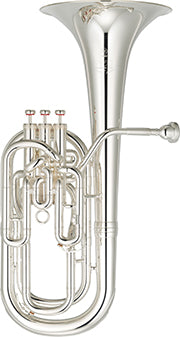
Baritone Learn More
Share
The difference in sizes for baritones is caused by how tightly the the tubing is coiled. Very small “baby” baritones look about half the size of a regular baritone but they are really the same length and the same pitch. The tubing is just coiled tighter. Another version of the baritone has a different name. It’s called the euphonium. Euphoniums are played exactly like a baritone. The difference is similar to the difference between a trumpet and cornet. The tubing of the euphonium and cornet is more cone shaped or “conical” than the baritone and trumpet. However the euphonium is not a typical beginning instrument. Virtually all euphoniums are produced for advanced players. They tend to be more expensive and most have a fourth valve to allow use of advanced alternate fingerings. Beginners should use a baritone rather than a euphonium.
The baritone has unique uses in various types of groups. We can hear baritones in bands, small ensembles or as a solo instrument. On the professional level, baritones or euphoniums are used heavily in military bands.
The Birth of the Baritone
The first tuba was made on September 12, 1835
One of the seminal events in the history of brass instruments was the invention of the valve apparatus in the 1820s. After their invention, valves were incorporated into a variety of brass instruments and spurred the creation of one new musical device after another. The basstuba, historical precursor to the modern tuba, made its appearance on September 12, 1835.
The German military bandmaster Wilhelm Wieprecht and the musical instrument inventor Johann Moritz were the basstuba's creators. September 12, 1835 was the date that Moritz filed the patent application for this instrument.
Named after an ancient instrument?
The name "tuba" comes from the Latin word for "tube," but was also used for an ancient bronze instrument used in Greece and Rome. The name was later used as a blanket term for horns, trumpets, and bugles. Moritz called his invention the "basstuba" since it had a lower tone than historical "tubas."
What low-pitched brass instruments existed before the modern tuba?
Before the trumpet and horn were equipped with valves in the 19th century, they were used in simpler forms without valves. However, since the tuba was invented in the 19th century, it had valves from the very beginning.
What type of instruments filled the role of the tuba before it was invented?
Although their structures were entirely different from the tuba, the ophicleide, serpent, and other instruments had a similar function to the modern tube in orchestras. Widely used until the mid-19th century, these used keys (metal caps over the tone holes) like woodwind instruments. For example, Mendelssohn's overture A Midsummer Night's Dream (1826) calls for an ophicleide. Also, when Wagner first wrote his Faust Overture in 1840, he did so with the serpent, not the basstuba, in mind.
Twists and Turns in the Development of the Tuba
Did the euphonium come from the tenor tuba?
Three years after inventing the basstuba, Moritz created the tenor tuba, an instrument with a higher tonal range. A fellow German named Ferdinand Sommer made the tubes of the tenor tuba thicker and more tapered. He called this instrument the "euphonium." The name was taken from "euphonos," which means "beautiful sound" in Greek.
A different instrument steals the euphonium's name!
While Sommer was developing the euphonium in Germany, Adolphe Sax, noted father of the saxophone, was creating one saxhorn instrument after another in Paris. First the sopranino, then the soprano, alto, tenor, and baritone saxhorns all had high tonal ranges that exactly matched the increasingly popular euphonium. The bass saxhorn, in fact, was sold under the name euphonium and was a great success.
Incidentally, the baritone saxhorn made by Adolphe Sax became the prototype for the modern baritone, which, although seldom used in typical brass bands, is an indispensable instrument in British-style brass bands.
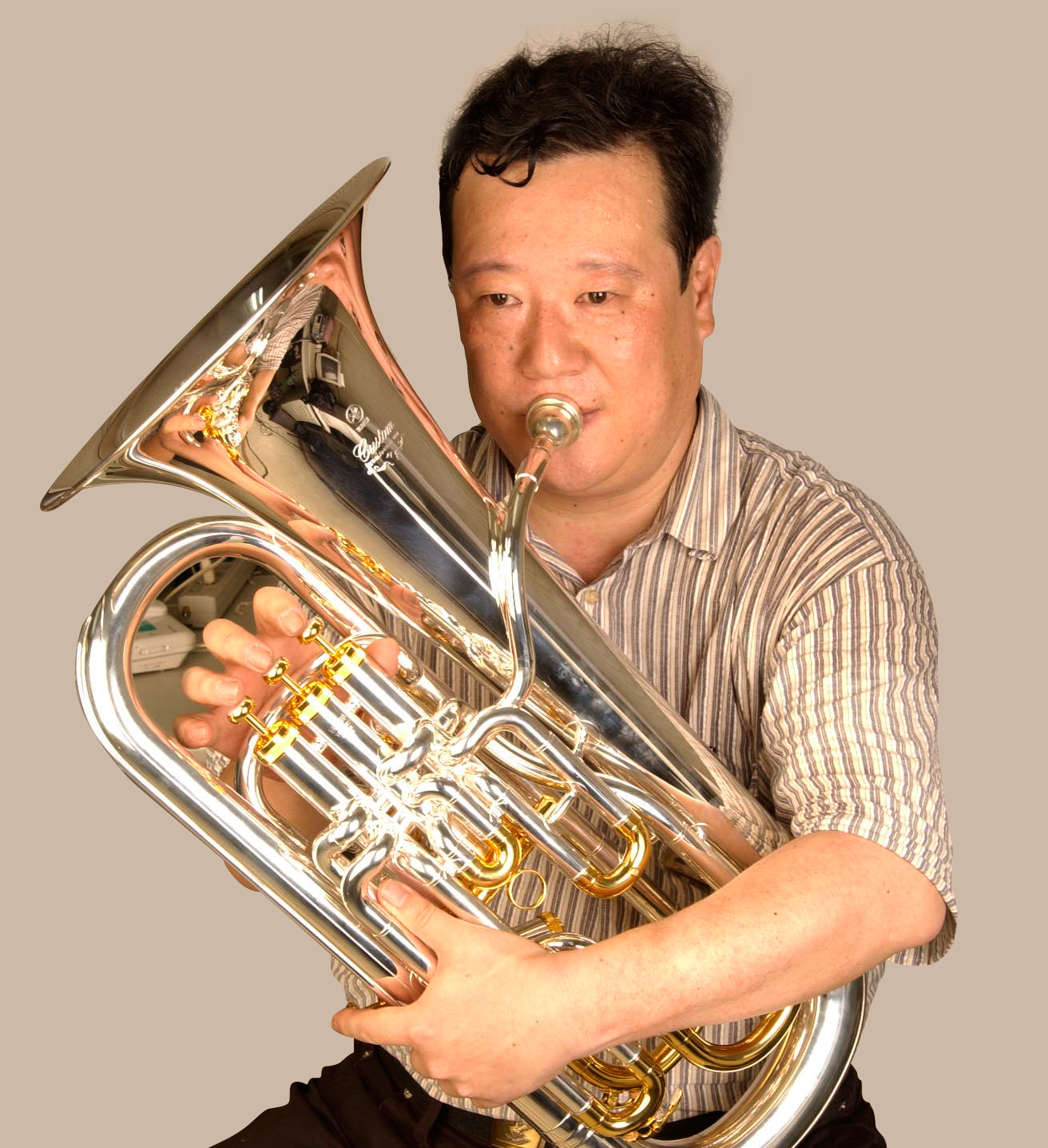
The modern euphonium
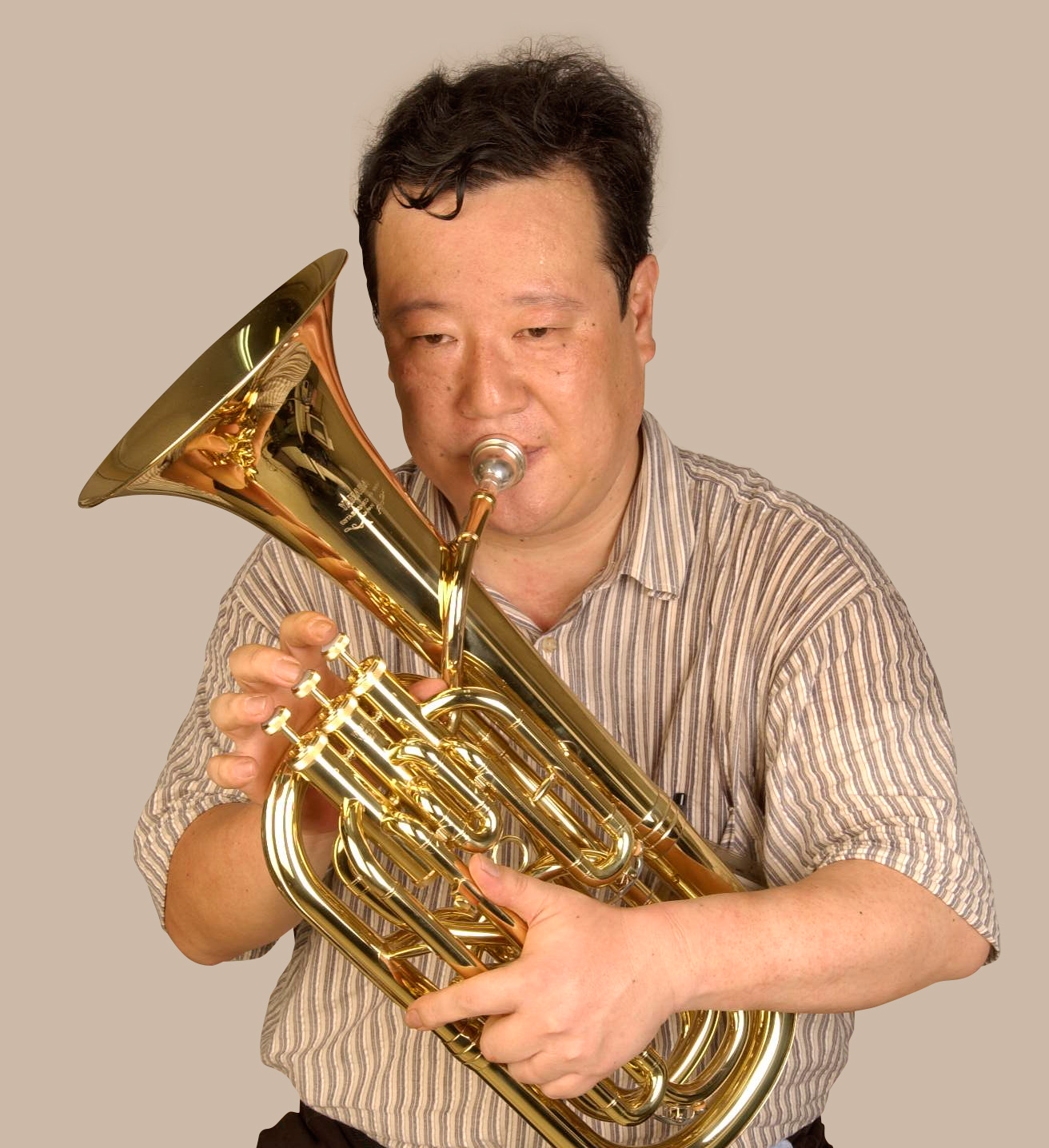
The modern baritone (also called a baritone horn)
Another low-pitched instrument is born!
As various brass instruments with low tones were being created, the one with the deepest pitch came in the 1840s by a Czech craftsman named V. F. Červený. A modern tuba is typically a C or B♭ tuba. As an instrument, the tuba can have various pitches, but these were not all invented by the same person. Craftsmen in various situations came up with diverse ideas and created instruments that were vetted in actual use, eventually leaving us with the instruments we use today. As a group, we call them tubas.
Tonal ranges of mid- and low-pitched brass instruments including the tuba
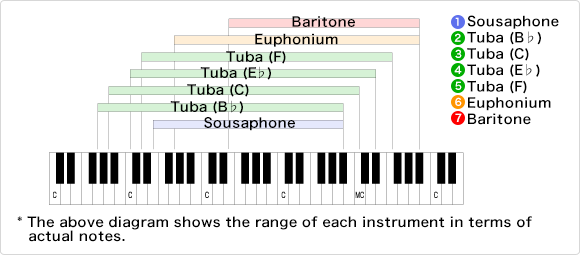
*The above diagram shows the range of each instrument in terms of actual notes.
The baritone
Usually equipped with three piston valves, this B♭ horn has the same tonal range as the euphonium. Some euphonium and trombone players will also play the baritone.
The timbre is bright and the tubes are considerably thinner than the euphonium. Despite having tubes thinner than the euphonium, the B♭ horn is called the baritone.
In the U.S., a euphonium with the bell and pistons facing forward may be called a baritone to differentiate it from a true euphonium.
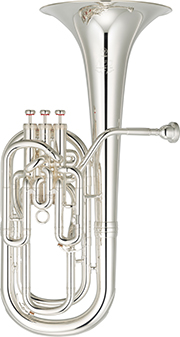
Can smaller people and women play the tuba?
You may have heard that the tuba is not suited to smaller people or those with less robust lung capacity. However, this is not necessarily true. To be sure, the tuba requires more lung capacity than a clarinet or trumpet, but it pales in comparison to the flute. There are women of small physical stature who are professional tubaists. Anyone with normal lung capacity is encouraged to give it a try.
Lung capacity can be increased through deep breathing
There is no denying that having greater lung capacity is an advantage for playing larger tubas. Dedicating some time to daily training can assist with increasing your lung capacity. The ideal approach would be to adopt an exercise habit like swimming or jogging. If this is not feasible, you might want to try deep breathing practice called "abdominal breathing." If you practice breathing by using your abdominal muscles to fully exhale to the bottom of your abdomen, you will boost your lung capacity while also increasing control of your breath.
